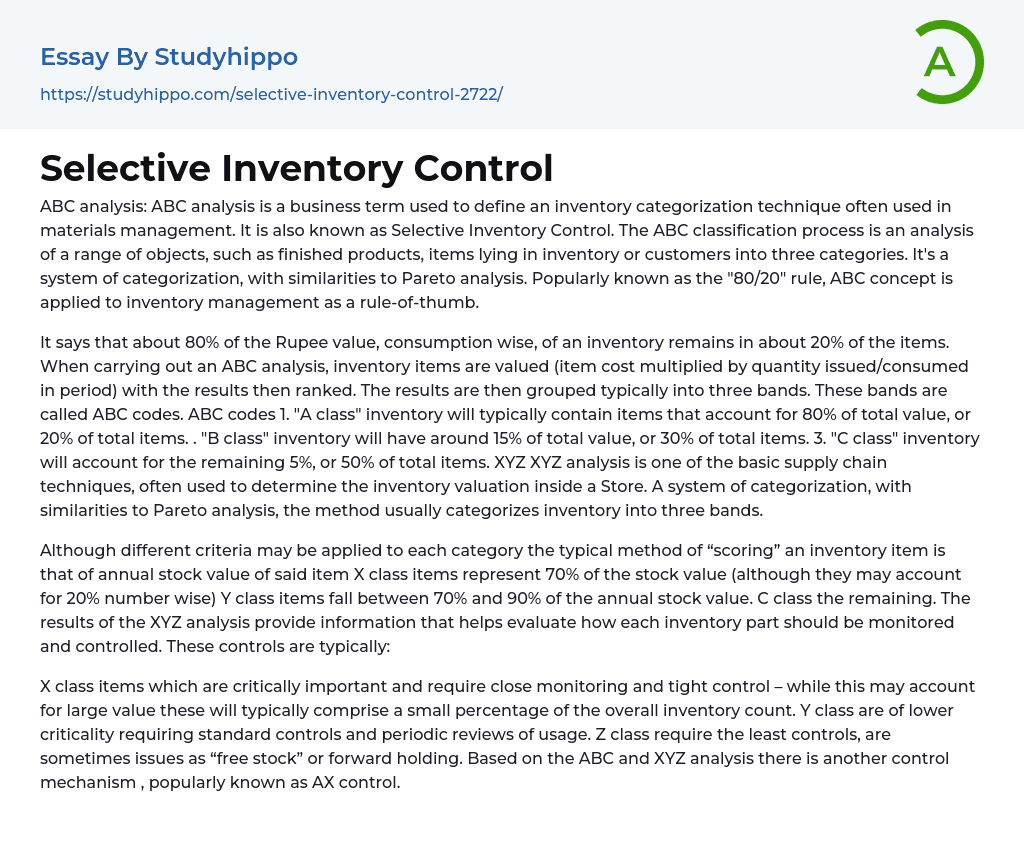ABC analysis: ABC analysis is a business term used to define an inventory categorization technique often used in materials management. It is also known as Selective Inventory Control. The ABC classification process is an analysis of a range of objects, such as finished products, items lying in inventory or customers into three categories. It's a system of categorization, with similarities to Pareto analysis. Popularly known as the "80/20" rule, ABC concept is applied to inventory management as a rule-of-thumb.
It says that about 80% of the Rupee value, consumption wise, of an inventory remains in about 20% of the items. When carrying out an ABC analysis, inventory items are valued (item cost multiplied by quantity issued/consumed in period) with the results then ranked. The results are then grouped typically into three bands. The
...se bands are called ABC codes. ABC codes 1. "A class" inventory will typically contain items that account for 80% of total value, or 20% of total items. . "B class" inventory will have around 15% of total value, or 30% of total items. 3. "C class" inventory will account for the remaining 5%, or 50% of total items. XYZ XYZ analysis is one of the basic supply chain techniques, often used to determine the inventory valuation inside a Store. A system of categorization, with similarities to Pareto analysis, the method usually categorizes inventory into three bands.
Although different criteria may be applied to each category the typical method of “scoring” an inventory item is that of annual stock value of said item X class items represent 70% of the stock value (although they may account for 20% number wise) Y class items fall betwee
70% and 90% of the annual stock value. C class the remaining. The results of the XYZ analysis provide information that helps evaluate how each inventory part should be monitored and controlled. These controls are typically:
X class items which are critically important and require close monitoring and tight control – while this may account for large value these will typically comprise a small percentage of the overall inventory count. Y class are of lower criticality requiring standard controls and periodic reviews of usage. Z class require the least controls, are sometimes issues as “free stock” or forward holding. Based on the ABC and XYZ analysis there is another control mechanism , popularly known as AX control.
- Chief Executive Officer essays
- Convenience Store essays
- Firm essays
- Training And Development essays
- Unilever essays
- Variable Cost essays
- Virgin Group essays
- Bargaining essays
- Entity essays
- Pest analysis essays
- John Locke essays
- 9/11 essays
- A Good Teacher essays
- A Healthy Diet essays
- A Modest Proposal essays
- A&P essays
- Academic Achievement essays
- Achievement essays
- Achieving goals essays
- Admission essays
- Advantages And Disadvantages Of Internet essays
- Alcoholic drinks essays
- Ammonia essays
- Analytical essays
- Ancient Olympic Games essays
- APA essays
- Arabian Peninsula essays
- Argument essays
- Argumentative essays
- Art essays
- Atlantic Ocean essays
- Auto-ethnography essays
- Autobiography essays
- Ballad essays
- Batman essays
- Binge Eating essays
- Black Power Movement essays
- Blogger essays
- Body Mass Index essays
- Book I Want a Wife essays
- Boycott essays
- Breastfeeding essays
- Bulimia Nervosa essays
- Business essays
- Business Process essays
- Canterbury essays
- Carbonate essays
- Catalina de Erauso essays
- Cause and Effect essays
- Cesar Chavez essays




